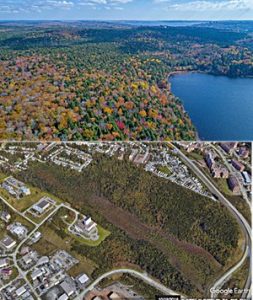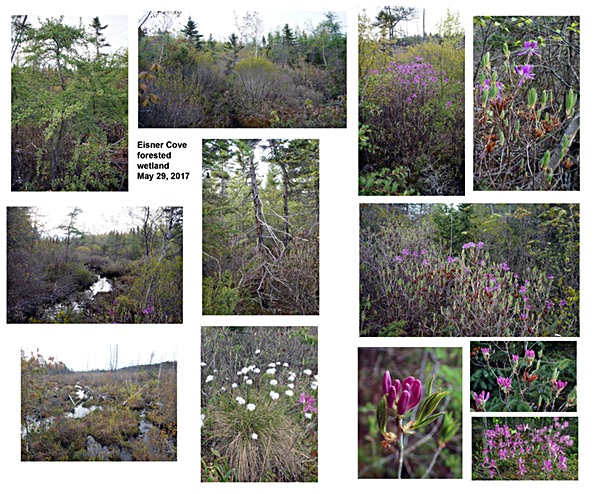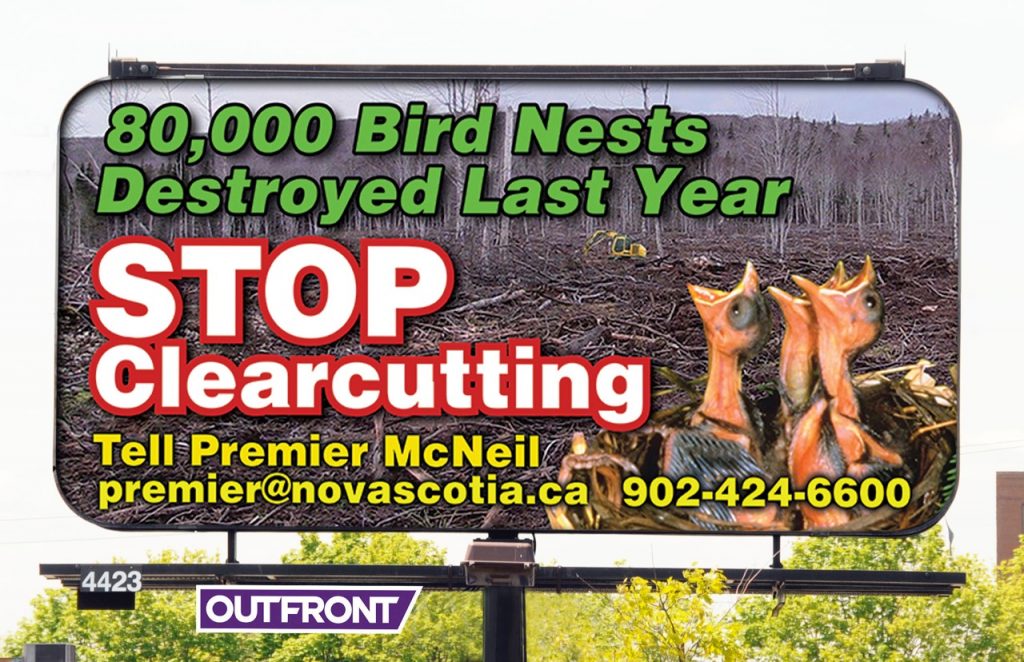
The Sandy Lake area (top) stretches between the Sackville River and Hammonds Plains Road of Bedford. The small forested in Dartmouth stands out in Google images.
Click on image for a larger version
While loss of old forest habitat associated with extensive clearcutting on short rotations in more rural areas is considered by ecologists to be the #1 threat to forest biodiversity in Nova Scotia, bulldozers in and around the more urban areas continue to do their part. The areas may be relatively small on a provincial basis and compared to clearcuts, but they can be important ecologically, and socially – and the losses are permanent.
Developers are aware of the social aspect and where valued old trees are involved, some have chosen to cut first and respond to (or ignore) outrage later, all empowered by the lack of any regulations on cutting trees on private land in Nova Scotia even in urban areas.
The cutting of the Boscobel hemlocks in Halifax in 2012 by the usually venerated Ken Rowe/IMP group was an especially shocking instance of a “surprise cut”:
“There was no community involvement or knowledge of the proposal… We just woke up one morning in March 2012 to the sounds of industrial-scale logging equipment clearcutting what used to be a beautiful heritage urban forestry site with beautiful huge hemlocks.”
Linda Mosher, HRM councillor for the area, told the Chronicle Herald at the time that no rules were being broken and that property owners have the right to clear vegetation from their lands without a permit. – From: Paving paradise in Jollimore. Clearcutting, lack of consultation and damage to cemetery have residents upset Halifax Media Co-op, Nov 10, 2013
In another case, in 2013 trees were cut out of anger:
In 2013, Armco Inc, a development firm, is told their land near Sandy Lake will not be considered for development for at least 10 years. They then clearcut an enormous section of it, including old-growth, hemlock forest. – Our HRM Alliance, 2015
Even the riparian areas – normally requiring a 20 or 30 m buffer even on private lands – were not spared due to a glitch in the regulations.
So it is in Nova Scotia, where the “principle” that we can’t regulate tree-cutting on private land is sacrosanct. Put a back deck on your house, and you need a permit and it has to conform to detailed regulations; or if your oil tank leaks, it could cost $200K to clean it up. But there is no problem with cutting down a stand of 200-year-old trees regardless of the environmental or social impacts.
Two areas in Halifax-Dartmouth that I know well are currently at risk of being developed or degraded by development. One is the land clearcut in 2013, cited above, since sold to another developer. The area around Sandy Lake (Bedford) was identified nearly 50 years ago “as one of seven unique “jewels in the crown” of Halifax-Dartmouth that should be protected for their ecological richness and for community education and recreation”. It remains only partially protected today and if the clearcut land (and more) is developed, that will likely spell the end of the Sandy Lake to Sackville River watercourse as habitat for sea-going species including salmon; and it will seriously undermine the ecological integrity of “the whole sweep of forest [that] provides a wildlife corridor at the neck of the Chebucto peninsula, north to the Sackville River and the mainland” and that contains significant Old Growth stands, at least one of the stands over 200 years old.
View: COMMENTARY: Spare HRM’s Sandy Lake ‘jewel’ in suburban HRM from bulldozers
Karen Robinson, Chronicle Herald Mar 7, 2018
The other area is a near pristine, approx 15 ha forested wetland located within a densely settled area of Dartmouth. The downstream wetland corridor was filled in years ago, but somehow this “Eisner’s Cove Wetland’ was spared.* Mixed Acadian forest occurs on the slopes north and south of the wetland. The threat is revealed by an ad in allnovascotia.com, March 5, 2018 which reads:
INNOVACORP OFFERS MASSIVE DARTMOUTH ACREAGE. Devin Stevens. Government venture capital agency is inviting property developers to submit potential uses for more than 100 acres of land just inside Dartmouth’s Circumferential Highway, and the lease could be for the next 100 years.
It’s not clear at this point whether infilling of the wetland is being considered but a request for a zoning change makes it clear that InnvaCorp intends to expand or sell land on the slope down to the wetland itself. That land was owned by the Province at one time, presumably it was turned over gratis to InnovaCorp, “Nova Scotia’s early stage venture capital organization”, when this quasi-government entity was formed; its target industries include “information technology, clean technology, life sciences and ocean technology”. Perhaps some of the targets like Cellufuel are not performing as anticipated, so they are cashing in some of their publicly donated real-estate.
_______
*It’s not clear why it is called “Eisner’s Cove Wetland” as it currently drains to the northwest and ultimately into MicMac Lake, not southeast towards Eisner’s Cove, although perhaps it did before the Circumferential Highway was built.

Eisner Cove Wetland at peak Rhodora time, courtesy of the NS Wild Flora Society.
Click on image for a larger version.
Local citizenry has struggled to keep both areas intact. The information about the Eisner Cove Wetland was sent to me by B.Z. who maintains a Facebook group Save Eisner Cove Wetland. For more details about rezoning, neighbourhood concerns etc, view Item No. 13.1.1 Harbour East – Marine Drive Community Council (February 2, 2017)
For more info about Sandy Lake, Bedford, view Sandy Lake Conservation Association, the recent op-ed and Sandy Lake and Environs.
Halifax is ahead of DNR in landscape level planning for biodiversity conservation and social values; some developers are on board, some not.
Unlike most Canadian cities, the urban core of Halifax is surrounded not by farms or endless burbs but by forested and coastal landscapes. Even within 30 kilometres of downtown Halifax, where approximately three-quarters of the population resides, developed areas are interspersed with substantive wild spaces. Very much to its credit, Halifax (referring to Halifax Regional Municipality which includes all of Halifax County) has recognized the importance of its wild spaces, most of them forested, and is developing a Green Network Plan which includes recognition of key wildlife corridors. The plan has been in the works for several years and is to be completed this year. That exercise is, apparently, well ahead of anything comparable by NSDNR, also, unlike plans developed in the NSDNR bunker, it has involved a lot of reports, public input etc.
In the meantime, in the lead-up to the plan, developers continue to press their interests, but there have been exceptions. Of note, Clayton Properties of the Shaw Group which had plans to develop the “Williams Lake Backlands” just off the Halifax Peninsula, changed course following a concerted campaign by citizens, and negotiated with HRM and the Nature Conservancy of Canada to sell the land to HRM for an “urban wilderness park” to be managed by HRM and NCC. (View: Urban wilderness park given the go-ahead.) That set a bit of a precedent for HRM to purchase privately held land for parkland, but it was consistent with the direction being set by development of the Green Network Plan.
More recently, in early 2018 HRM was able to negotiate and purchase 80 hectares of wilderness land from West Bedford Holdings to go towards the Blue Mountain Birch Cove Lakes Regional Park; that was one of three private pieces of land HRM wants to acquire. One of the other land holders, the Annapolis group, on the other hand, is holding out and has threatened to sue HRM.
Legislative Action required at Municipal/County and Provinical levels
Of course, although developers have the right to cut trees on land they own, it the elected representatives who can change the rules to better reflect public interest and ensure the rules are applied, and it is up to citizens to elect representatives who reflect their interests and to hold them to account.
The Green Network Plan will lay out options for legislative action, but as I understand it, acceptance of the plan by HRM will not in itself protect the designated wild spaces, corridors etc. Moving legislatively will be a slow process, likely requiring some changes in provincial legislation for certain aspects – notably for introducing any constraints on private landowners rights to do what they want with trees on their properties.
It is not just urban and suburban folks in Halifax Co, who are concerned about tree cutting. If anything shook Premier McNeil about clearcutting in Nova Scotia and led to the Independent Review of Forest Practices, it was the letter from the Annapolis County Council – in his own riding – requesting that the county be excluded from the impending WestFor agreement, the warden later expressing the notion that the municipality should have a say in forestry practices.
In this regard, the Province could well look to Ontario which introduced legislation enabling lower levels of government (counties, regional governments, cities and towns) to pass “tree bylaws” – in 1946! (View Tree Marking – why not in Nova Scotia? Post Nov 10, 2016.) Lets hope the Independent Review will recommend action of that sort.
Until we have more comprehensive perspectives of our landscapes such as will be afforded by the Green Network Plan for Halifax, and legisplation to go with it, areas such as Sandy Lake and Environs and the Eisner Cove Wetland, and innumerable other sites all over Nova Scotia that are valued by local citizenry will be fought case by case as they are threatened, sometimes with good outcomes, sometimes not, and sometimes axed before they even have a chance to defend them.
Not to mention the many sites and species that have no local public defenders.
—————————————————————————————
Some comments on this post:
Woods and Waters Nova Scotia, GF: “I can certainly relate to this one . The development along lakes and rivers needs to be reexaminaded. Places I could once trap muskrats or go fishing no more.”
RN: Yes in some areas sub divisions were developed in the centre of wildlife bedding areas. A wildlife habitat assessment is just as important as environmental plan and approval should be given before development can proceed.
GF: Perhaps the actual foot print of these places add up to a lot more then we think.
RN: yes it be interesting to see a map of what was lost in this province to development in the last 40 yrs. It most likely shock us, not that were are environmentalist, tree hugging fanatics. As good stewards of the land, we need to be more proactive on lobbing for a strategy of where we are going. Protection of farm land is already a priority in some counties.
Received from WR: “One thing that the Dartmouth Plan does is it specifically maps protected wetlands and Eisener’s Marsh is one of them. It means that you can’t go through whatever the provincial process is to wipe it out. The upland forest areas more than 30 meters off the wetland area could be developed though.”
– I am trying to find more on this. My understanding is that any alteration of a wetland of 2 ha or larger is subject to a provincial Environmental Assessment. If approved to infill, the developer would be required to finance construction of a wetland elsewhere, as was the case for the nearby Russel Lake Wetland. (View also A Citizen’s Guide to Wetland Conservation in the Halifax Regional Municipality.) Regardless, the watershed in which the Eisner Cove wetland is situated is a small one and development of rezoned INNOVACORP land (if finally approved), would remove healthy mixed Acadian forest on the slope, likely impacting the wetland, and destroying a popular walking area for the neighbourhood.


